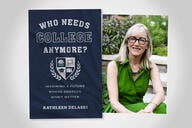You have /5 articles left.
Sign up for a free account or log in.
BOSTON – The Forum on Education Abroad conference, which ended Friday, featured a dizzying array of sessions on evaluating student learning overseas and the impact of the study abroad experience.
Panelists discussed the use of various standardized assessment tools, like the Intercultural Development Inventory and the Beliefs, Events and Values Inventory, and ongoing large-scale research projects, like the California Community College Student Outcomes Abroad Research Project, and the Teagle Foundation-sponsored initiative on study abroad and liberal arts learning outcomes. The latter aims to test how specific program elements -- such as program duration, housing type, and language requirements -- affect student learning.
Three associations of liberal arts colleges – the Associated Colleges of the Midwest, Great Lakes Colleges Association and Associated Colleges of the South – developed the Learning from Study Abroad survey instrument, which is designed to test eight outcomes:
The ability to reason by developing an understanding that:
1. Culture influences how one thinks and reasons.
2. There are differences between cultures that influence norms.
3. Without being judgmental, cultural similarities and differences can be analytically compared and contrasted.
4. Certain universals of human existence transcend cultural differences.
Self-reflective insights that:
5. Allow one to understand that one’s culture has shaped his/her values or beliefs.
6. Allow one to continue the development of his/her personal identity (values, beliefs, goals, etc.) based on a multicultural perspective.
A capacity for effective action, which includes:
7. The skills to operate effectively in multicultural and intercultural situations.
8. The motivation to address issues of contemporary global concern.
The survey asks for information about demographics, previous foreign language experience, interest in and motivation for study abroad, and prior study abroad experience (including familiarity with the site of study). Students are also asked to respond to a series of hypothetical scenarios and statements designed to measure their achievement of the above learning goals. For example, students would rate whether they agreed or disagreed, on a 1-7 point scale, with the item, “I make judgments about other people’s customs based on historical and political context.”
The survey is administered pre- and post-study abroad, and the post-test includes the same scenarios and statements, in addition to a self-assessment section and a series of questions about program components -- location, length, language requirements, the nature of the orientation (its length, timing, content), the nature of courses, evaluation of student work, educational relationships, out-of-class interaction, housing arrangements, post-experience debriefing, etc.
John Ottenhoff, vice president of the Associated Colleges of the Midwest, said the association began to administer the online survey to all students enrolled in ACM programs last fall, but given the length of the survey and the need for a pre- and post-test, obtaining a good response rate remains a challenge.
Helena Kaufman, director of off-campus studies at Carleton College, has administered the survey to Carleton students. While she hasn’t yet mined the data on intercultural learning outcomes, she has found some interesting preliminary results just in terms of demographics. Notably, 85.5 percent of Carleton students going abroad had previous international experience, and 40.6 percent had previously studied abroad.
The number-one reason for participation was to learn another language or culture, but number two had more to do with the climate at home -- the idea that study abroad was expected at Carleton. As Kaufman put it, “It’s expected that at one point or another you will go.” About three-quarters of Carleton students study abroad.
Outside the arena of liberal arts colleges, another major research project, discussed at the Forum conference, involves the California community colleges, and is focused in large part on academic outcomes once students return home. The California Community College Student Outcomes Abroad Research Project (CCC SOAR) is funded by a U.S. Department of Education grant, awarded to Gary Rhodes, at the Center for Global Education at the University of California at Los Angeles, and it aims to determine the profile and academic outcomes of two-year college students who study abroad.
Other studies, including the systemwide GLOSSARI Project, in Georgia, have found higher grade point averages and graduation rates among students who study abroad, but the question is, what is the effect for community college students specifically? And, to take a step back, what are the characteristics of community college students who choose to study abroad in the first place? “We’re going to have a really good understanding of who these students are,” said Rosalind Latiner Raby, the director of California Colleges for International Education and co-principal investigator. “It’s really an understanding we don’t have now.”
As Raby explains, by working with the California Community College Chancellor’s Office, the researchers will be able to track measures of academic success, as well as obtain data on demographics and previous coursework, for all California community college students who studied abroad on faculty-led programs from 2002 to 2010 (on average, about 3,500 students from across the system study abroad each year, Raby said). They will also be administering a qualitative pre- and post-study abroad survey, to be piloted this summer or fall, focused on the attainment of student goals and international learning outcomes.
The final question is, what does success even mean in the context of community colleges? In the quantitative analysis, the researchers aim to consider a variety of different measures of success – GPA and transfer to and graduation from a four-year institution, but also, for example, completion of a certificate or vocational program, or persistence (such as through a remedial course sequence). “The community college mission is wide; there are so many components to it,” Raby said. “We’re going to be breaking it down.”




